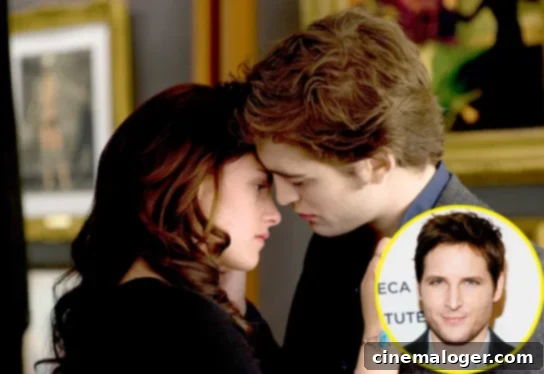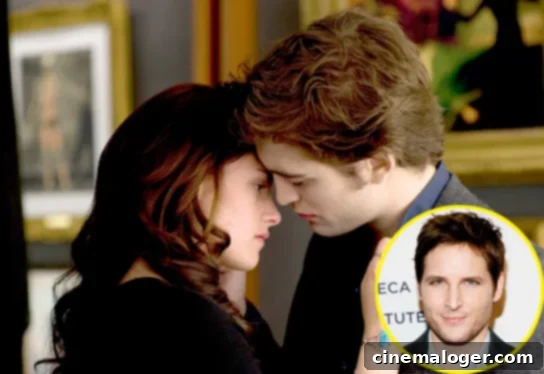
Breaking Dawn’s Intimacy: Peter Facinelli Weighs In on PG-13 Debate for Twilight’s Youngest Fans
The anticipation for Edward Cullen and Bella Swan’s long-awaited marital consummation in The Twilight Saga: Breaking Dawn – Part 1 reached a fever pitch among fans worldwide. For years, readers of Stephenie Meyer’s bestselling novels had followed the intense, chaste romance between the vampire Edward and human Bella, culminating in their wedding and the highly anticipated honeymoon. This pivotal moment, a turning point in their epic love story, promised to be the most intimate and defining sequence in the entire film franchise. Millions of dedicated Twi-hards, from tweens to adults, eagerly awaited the big screen adaptation, imagining how the filmmakers would bring this deeply significant chapter to life.
However, amidst the excitement for the “sweet, sweet love” finally shared between Robert Pattinson and Kristen Stewart’s iconic characters, a crucial question began to surface: How would the film portray such passionate scenes while remaining appropriate for its vast and often young audience? This concern gained significant traction when a prominent member of the Cullen family, actor Peter Facinelli, who brilliantly portrays the wise and compassionate vampire patriarch Carlisle Cullen, publicly addressed the delicate balance between satisfying fan expectations and maintaining family-friendly content. His insights sparked a broader discussion about the responsibility filmmakers have to their audience, especially when that audience spans a wide age demographic.
Peter Facinelli’s Paternal Perspective on Twilight’s Racy Content
Peter Facinelli, known for his thoughtful performances and his dedication to his craft, brought a uniquely personal and relatable perspective to the intensifying debate surrounding the intimate scenes in Breaking Dawn. As a father himself, his comments resonated with many parents and guardians within the extensive Twilight fanbase. Speaking exclusively to HollywoodLife.com on January 16 at Lionsgate’s pre-Golden Globes party, Facinelli revealed the dual considerations weighing on his mind, perfectly encapsulating the dilemma faced by the film’s producers and director.
“I have a 12-year-old daughter [Luca Bella, whose mom is Jennie Garth],” Peter, then 37, explained. “She’s a fan and I’d want her not to feel left out or awkward.” This statement went straight to the heart of the matter. For a franchise that had, for the most part, maintained a relatively chaste and romantic tone suitable for pre-teen and teen audiences, introducing overtly “hot and heavy” sequences presented a potential barrier. Many young fans, like Luca Bella, had grown up with the saga, investing emotionally in Edward and Bella’s journey. Excluding them, or making them uncomfortable during a viewing experience, was a genuine concern for Facinelli and countless other parents.
Facinelli further elaborated on his hopes for the film’s approach, stating, “Hopefully it’s a PG-13 type of situation. I’m sure the producers and directors know what they want—and especially what they are doing—but I’m sure they don’t want to alienate fans.” His words highlighted a nuanced understanding of the filmmaking process and the commercial realities involved. He expressed confidence in the creative team’s ability to navigate this challenge while simultaneously voicing a desire for an outcome that honored the spirit of the books without crossing into more explicit territory that would necessitate an R-rating. A PG-13 rating would ensure the widest possible audience could continue to enjoy the final chapters of the saga together, a crucial consideration for a franchise built on a shared, communal fandom.
Navigating the Twilight Conundrum: Authenticity vs. Accessibility
Peter Facinelli’s thoughtful comments perfectly articulated the “Twilight conundrum” that faced the filmmakers of Breaking Dawn. On one hand, there was an immense pressure to deliver an authentic adaptation of Stephenie Meyer’s novel, which vividly describes the passionate intimacy shared between Edward and Bella. Fans had waited through three previous films for this culmination, and anything less than a compelling, albeit tastefully handled, depiction of their first nights together might feel like a disservice to the source material and the emotional build-up. The consummation of their love was not merely a physical act but a profound expression of their bond, their commitment, and the ultimate acceptance of their unique existence.
However, the other side of the coin presented a significant challenge: the franchise’s massive and devoted fanbase included a substantial demographic of younger viewers. Many tweens and young teenagers had been drawn to the romance, fantasy, and character arcs of Twilight, and their parents often felt comfortable allowing them to engage with the saga due to its generally mild content. An explicit portrayal of the love scenes, pushing the boundaries beyond a PG-13 rating, risked alienating a large segment of this crucial audience. It could lead to parents restricting access to the film, disrupting family viewing traditions, and potentially damaging the franchise’s reputation as a relatively wholesome romantic fantasy.
The financial implications were also undeniable. A PG-13 rating is typically the sweet spot for blockbuster franchises aiming for maximum box office success, allowing broader access for younger audiences without alienating adults. An R-rating, while potentially appealing to a niche segment seeking more mature content, would inevitably cut off a significant portion of the core fanbase, impacting ticket sales, merchandise, and the overall cultural reach of the film. The dilemma for director Bill Condon and the producers was how to remain true to the intense emotional and physical intimacy described in the books while ensuring the film remained accessible and appropriate for the widest possible demographic of fans.
Finding the Happy Medium: Crafting PG-13 Intimacy
The question then became: could there be a happy medium? Could the filmmakers deliver scenes that were undeniably “hot and heavy” and faithful to the novel’s spirit, yet still fall within the acceptable parameters of a PG-13 rating? Achieving this balance requires skillful filmmaking, relying on implication, suggestion, and emotional intensity rather than explicit visuals. Directors often employ a range of techniques to convey intimacy without showing everything, engaging the audience’s imagination while respecting rating guidelines.
For Breaking Dawn, this could involve several creative choices. Close-ups focusing on the actors’ faces, conveying raw emotion and passion, rather than explicit body shots. Strategic camera angles, lighting, and shadow play could suggest intimacy without revealing all. Dialogue and non-verbal cues could emphasize the deep connection and desire between Edward and Bella. Furthermore, the use of sound design – heavy breathing, soft murmurs, or even symbolic sounds – can amplify the sense of passion without explicit imagery. The aftermath of the scenes, showing the characters’ post-intimacy emotions and reactions, can be just as powerful in conveying the significance of the moment as the act itself.
The key would be to focus on the emotional weight of the consummation: the culmination of their spiritual and physical journey, the union of two souls who had overcome impossible odds to be together. For fans, it was less about the mechanics of sex and more about the profound bond finally made complete. Peter Facinelli’s hope for a “PG-13 type of situation” underscored the belief that responsible storytelling could honor this pivotal moment in the saga while remaining inclusive of all its devoted followers. His loyalty, as he stated, ultimately rested with his family, highlighting the universal parental desire to protect and guide their children through media consumption—a sentiment that undoubtedly resonated with many parents of young Twi-hards.
In essence, the challenge for Breaking Dawn was to translate the passionate intensity of the book onto the screen in a way that felt authentic to the characters, satisfying to the adult fans, and yet still appropriate for younger viewers who had invested years in the saga. It was a testament to the broad appeal of Twilight that this debate even existed, signifying its unique position as a cultural phenomenon that transcended traditional demographic boundaries. The decisions made regarding these scenes would not only impact the film’s box office performance but also shape the enduring legacy of the entire franchise in the eyes of its diverse global fanbase.
Get more on ‘Twilight:’
- Would You Watch A Reality Show Set In The ‘Twilight’ Town Of Forks, Washington?
- Bryce Dallas Howard — How Did You Break Into The “Eclipse” Clique Without Getting Bitten?
- Twilight Cast Spill Eclipse Secrets!
